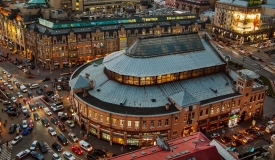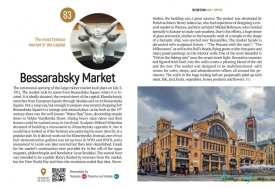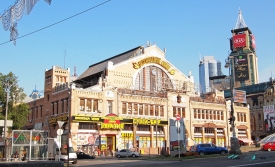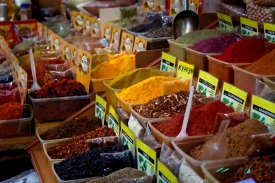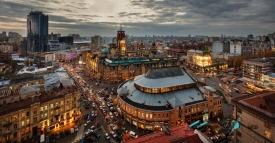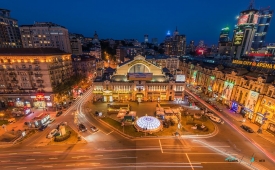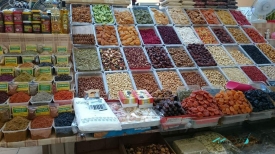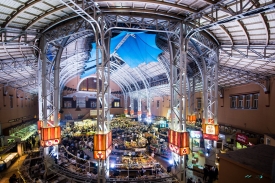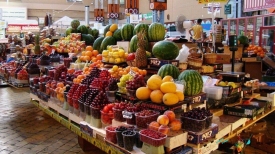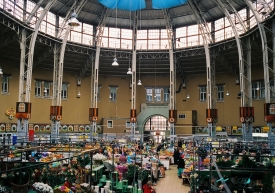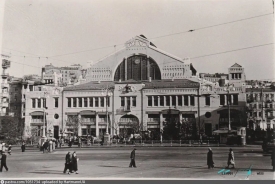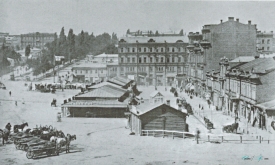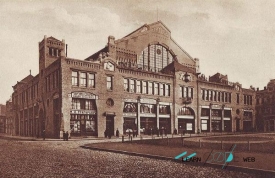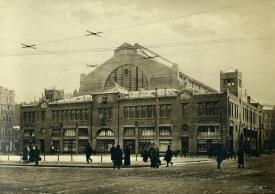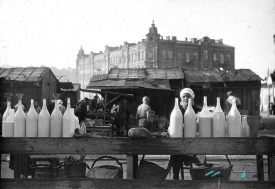Bessarabian Market (Bessarabka) is an indoor market with a trading area of 896 m2. on Bessarabian Square at the western end of Khreshchatyk in Kiev.
It was built in 1910-1912 on the money of the famous sugar manufacturer Lazar Brodsky, appointed by him for this purpose in his will.
The project was designed by architect Mikhail Bobrusov. The sculptural decoration was made by students of the Ukrainian sculptor Fedor Balavensky, who studied at the Kyiv Art School: Tetyana Rudenko-Shchelkan.
The grand opening of the market in the presence of the top leadership of the city and the region took place on 3 (16) July 1912 .
Historians still do not have a single version of the name of the market. Many believe that it owes its name to the import from the southern provinces, in particular, from Bessarabia. Others share the view of 19th-century Kyiv historian-priest Petro Lebedyntsev, who argued that local "bastards" were called "Bessarabia" in the first third of the 19th century. The Bastards allegedly found refuge on the then south-western outskirts of Kyiv, and therefore it was nicknamed "Bessarabian" .
According to Kyivites and guests of the Ukrainian capital, the Bessarabian market is the most expensive in Kyiv. The idioms "expensive as in Bessarabia" or "we are not in Bessarabia" (meaning "inappropriate bargaining") are firmly entrenched in the daily lives of Kiev.
For a long time, the territory occupied by the building of the Bessarabian covered market was located outside the historic city, along the line of the city fortifications that crossed Khreshchatyk. During the times of Kievan Rus, approximately along Velyka Vasylkivska Street, there was a "road to the land of the Pechenegs". In the eighteenth century. at the beginning of T. Shevchenko Boulevard there was a Lutheran cemetery.
In the 1830s and 1940s, the area was renamed Novoye Stroenie (New Building).
The network of streets in the area of Bessarabian Square was formed and included in the city limits after the approval of the new master plan of Kyiv in 1837. For almost the entire nineteenth century, Bessarabian Square remained untidy. In addition to the bazaar, Bessarabian Square housed an "exchange" of second-class carriage drivers.
It was built in 1910-1912 on the money of the famous sugar manufacturer Lazar Brodsky, appointed by him for this purpose in his will.
The project was designed by architect Mikhail Bobrusov. The sculptural decoration was made by students of the Ukrainian sculptor Fedor Balavensky, who studied at the Kyiv Art School: Tetyana Rudenko-Shchelkan.
The grand opening of the market in the presence of the top leadership of the city and the region took place on 3 (16) July 1912 .
Historians still do not have a single version of the name of the market. Many believe that it owes its name to the import from the southern provinces, in particular, from Bessarabia. Others share the view of 19th-century Kyiv historian-priest Petro Lebedyntsev, who argued that local "bastards" were called "Bessarabia" in the first third of the 19th century. The Bastards allegedly found refuge on the then south-western outskirts of Kyiv, and therefore it was nicknamed "Bessarabian" .
According to Kyivites and guests of the Ukrainian capital, the Bessarabian market is the most expensive in Kyiv. The idioms "expensive as in Bessarabia" or "we are not in Bessarabia" (meaning "inappropriate bargaining") are firmly entrenched in the daily lives of Kiev.
For a long time, the territory occupied by the building of the Bessarabian covered market was located outside the historic city, along the line of the city fortifications that crossed Khreshchatyk. During the times of Kievan Rus, approximately along Velyka Vasylkivska Street, there was a "road to the land of the Pechenegs". In the eighteenth century. at the beginning of T. Shevchenko Boulevard there was a Lutheran cemetery.
In the 1830s and 1940s, the area was renamed Novoye Stroenie (New Building).
The network of streets in the area of Bessarabian Square was formed and included in the city limits after the approval of the new master plan of Kyiv in 1837. For almost the entire nineteenth century, Bessarabian Square remained untidy. In addition to the bazaar, Bessarabian Square housed an "exchange" of second-class carriage drivers.



